Before my sisters and friends arrived for our road trip across Ireland, Sam and I had one week in Dublin. At first, I thought this would be too long, but once the wind started blowing and the rain started pouring, we were glad to have a few additional days to work around the weather. Our week in Dublin was very laid back, but in the end, we managed to see, eat and drink everything we wanted to. Here’s a look at what we got up to:
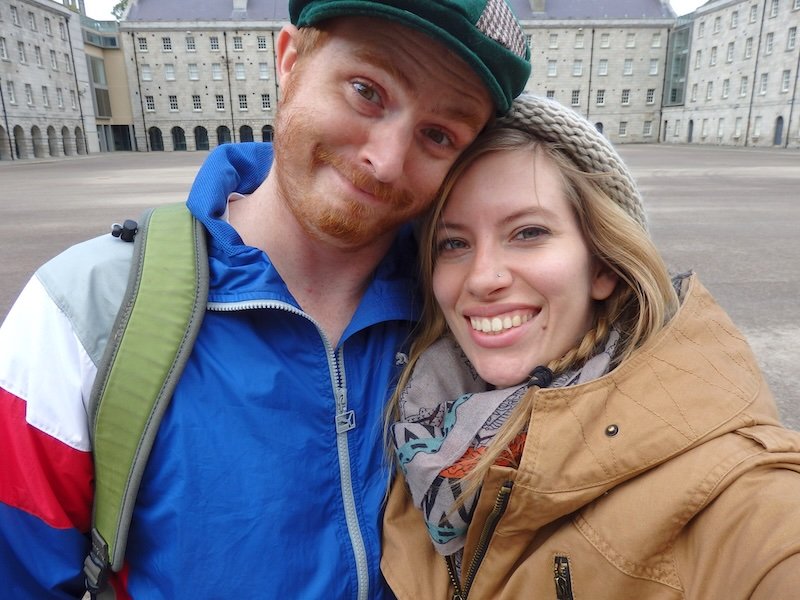
Dublin 1 Week Itinerary, Guide & Planner: Things to Do, See, Eat, Drink & Experience in Dublin


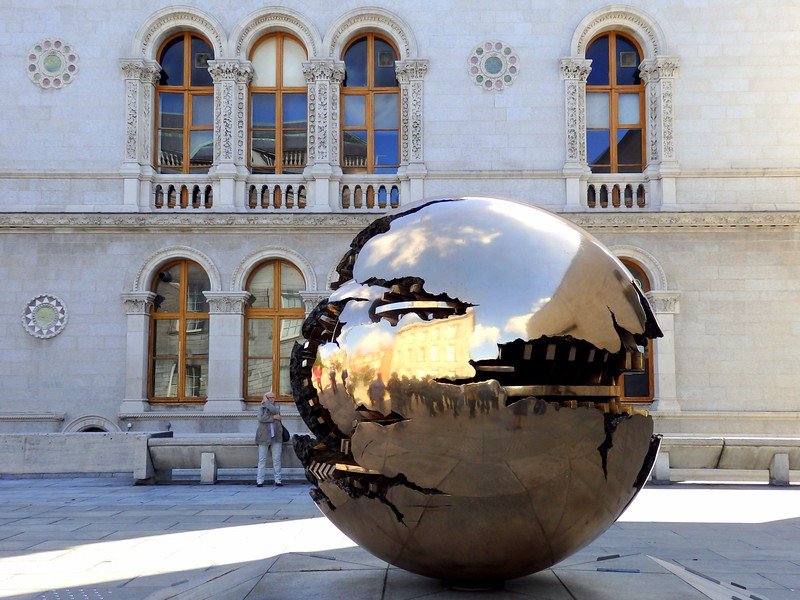
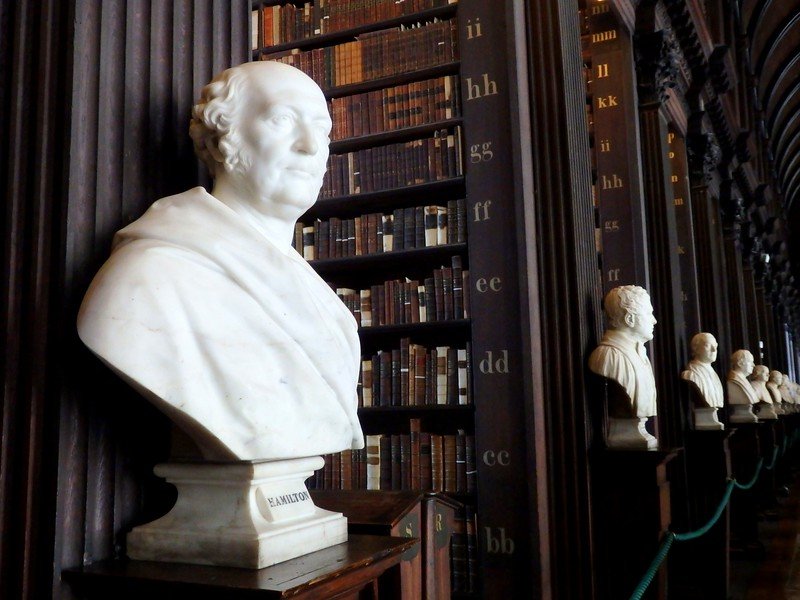
Tour Trinity College and see the Book of Kells
Even though I’m no longer a student, I still enjoy touring university campuses, especially when we’re talking about one as beautiful as Trinity College.
Sam and I signed up to do a campus tour which is run by current students, and it was really cool hearing about their experiences studying there as well as hearing all the good gossip on former students like Bram Stoker (Dracula), Jonathan Swift (Gulliver’s Travels), and Oscar Wilde (The Picture of Dorian Gray). Trinity College sure churned out a lot of writers!
The laugh out loud moment of the tour was me trying to decipher the tour guide’s name tag which read ‘Eoin’. How would you pronounce that?! Eee-oh-een? Well, apparently in Ireland that’s how you write the name ‘Owen. I felt like Amy Adams in the movie Leap Year when she’s trying to pronounce the bartender’s name which reads ‘Eoghan’. Eee-oh-ghan? Nope, apparently that is also pronounced ‘Owen’. Baffles me! When in doubt just go with Owen!
After the tour was finished, we had some time to visit the Old Library and see the Book of Kells at our own leisure. The Book of Kells is an illuminated manuscript that contains the four gospels and is believed to date back to the 1800s. The images were painted on calfskin using colourful inks from different parts of the world. Unfortunately, it was really crowded when I visited so it was almost impossible to get a good look or linger more than a few seconds before you were moved on by the pressing crowds.
That being said, the library itself was magical and it had that musty smell of old books that bibliophiles are sure to love.
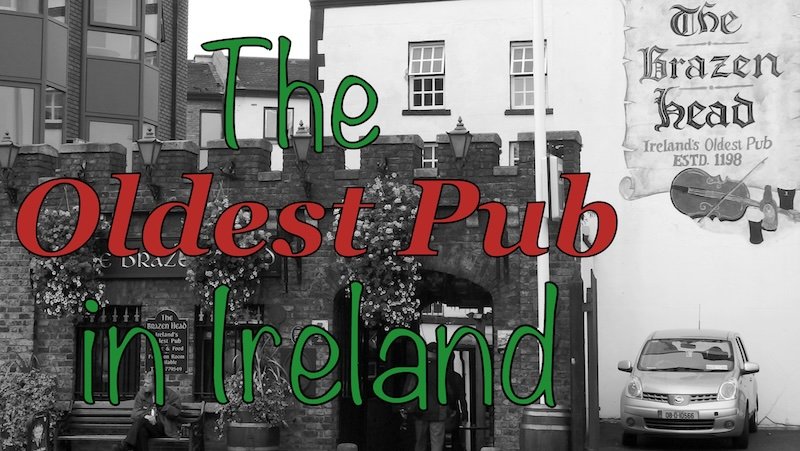
Have dinner in Ireland’s oldest pub
There’s no shortage of pubs in Dublin, but the one we were most interested in going to was The Brazen Head. What makes this place so special is that it is the oldest pub in all of Ireland. We wanted to see what that looked like, and it was surprisingly more modern that what we expected.
While they pub may date back to 1198, it is unclear how much of the original coach house is still intact. Many sections were added on much later than that, so what you get is an eclectic mix of rooms, terraces, and crooked doorways, all of which are very cozy!
The pub grub was pretty tasty too and they had all the classics from fish and chips to hamburgers and Irish stew. They also have live traditional music throughout the week; the most popular session is on Sunday afternoons between 3:30 and 6.30 p.m.
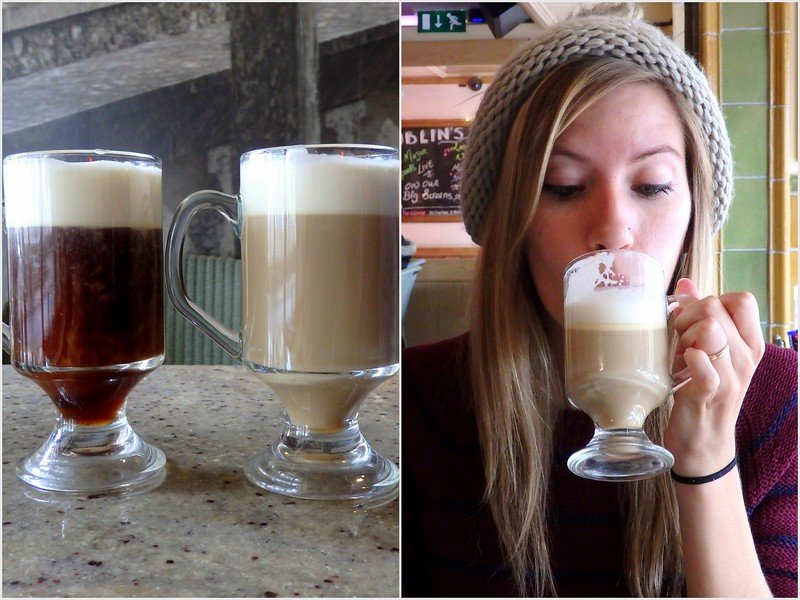
Drink an Irish coffee
There are two spiked coffees that we kept seeing on every menu: Irish Coffee and Bailey’s Irish Cream Coffee. On a chilly afternoon, Sam and I finally decided to put the two to the test. He ordered the Irish Coffee, which consists of hot coffee, Irish whiskey, and sugar topped with thick cream; while I ordered the Bailey’s Irish Cream Coffee, which combines hot coffee, Bailey’s Irish Cream, and whipped cream on top. I liked mine best!
Sample a bit of Irish whiskey
I’ve only just began to develop a taste for wine (mostly for Rieslings!), so while I wasn’t really into sampling something so strong as whiskey, Sam was more than happy to go off and do the drinking.
If you’re visiting Dublin and whiskey is your thing, then of course you’ll want to drop by the Old Jameson Distillery for a taste of Irish whiskey. Locates just off of Smithfield Square, this popular attraction offers guided tours, tutored whiskey tastings (what you’re probably after!), as well as bars, a restaurant, and a gift shop.
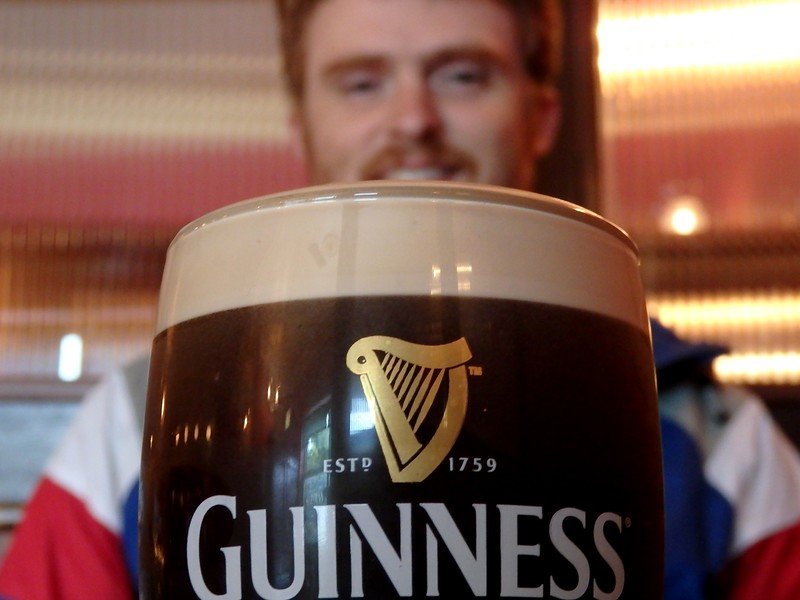
![]()
Have a pint of Guinness a day
And while we’re on the topic of booze, let’s talk about Guinness. You could just enjoy a pint of Guinness at a local pub, but if you want something a little extra special, you can head over to the Guinness Storehouse, which is an interactive museum dedicated to all things Guinness.
The Guinness journey begins at the bottom of the world’s largest pint and it continues up through seven floors that cover the long brewing heritage. At the top, you’re rewarded with a pint of the black stuff at the rooftop Gravity Bar.
Go looking for deer at Phoenix Park
Yes, you can find deer in the middle of Dublin!
How we ended up here is a bit of a funny story. Sam and I were wondering around town filming yet another video when we were stopped by a couple who greeted us with enthusiastic Italian accents, “You make the video!” It turns out they had come across our YouTube channel, so we ended up chatting with them. Since they had been living in Dublin for a while, we asked them what some of their favourite spots in Dublin were – Phoenix Park was at the top of their list – and so we made the trek out there based on their suggestion..
Now, we had no idea where to find the deer so we spent quite a bit of time walking around aimlessly before we finally found someone who pointed us in the right direction. To save you the trouble, the deer like to hang out near the woods just south of the Papal Cross and close to the Ambassador’s Residence, but they are most active at dawn and dusk. We were there late in the afternoon and managed to see one fairly close by – such a cool experience!

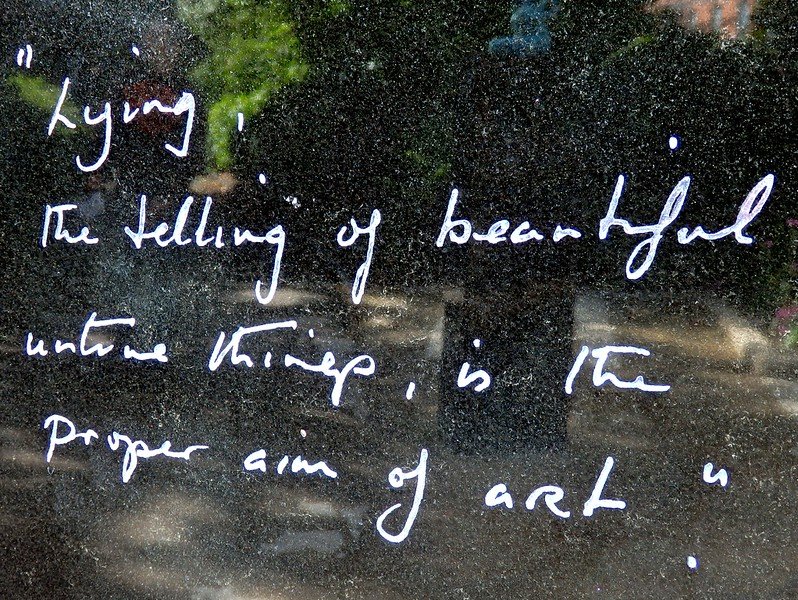
Find Oscar Wilde lounging at the park
Like I previously mentioned, many literary figures have called Dublin home, and Oscar Wilde was perhaps one of the best known.
If you want to see his childhood home, swing by Number One Merrion Square. Unfortunately, you can’t go inside the house since it is now owned by the American College Dublin, however, you can have a look at it from the exterior before crossing the street over to Merrion Square where you’ll find a smug statue of Wilde just lounging on a rock.
His statue is surrounded by black pillars inscribed with some of his most memorable quotes like:
Fashion is a form of ugliness so intolerable that we have to alter it every six months.
Some cause happiness wherever they go; others whenever they go.
Lying, the telling of beautiful untrue things, is the proper aim of art.
Shopping along the pedestrian streets
There are two main pedestrian shopping streets in Dublin: Henry Street and Grafton Street.
Henry Street is on the north side of the River Liffey. It runs from the Spire (a hard to miss landmark!) to Liffey street and it is lined with well known brands as well as souvenir shops where you can pick up your token ‘Kiss me, I’m Irish’ t-shirt or a tweed paddy cap if you’re my husband.
Your other option is Grafton Street, which sits on the south side of the river. It runs from Saint Stephen’s Green to College Green, where again, you can find well known brands as well as plenty of street performers along the way.
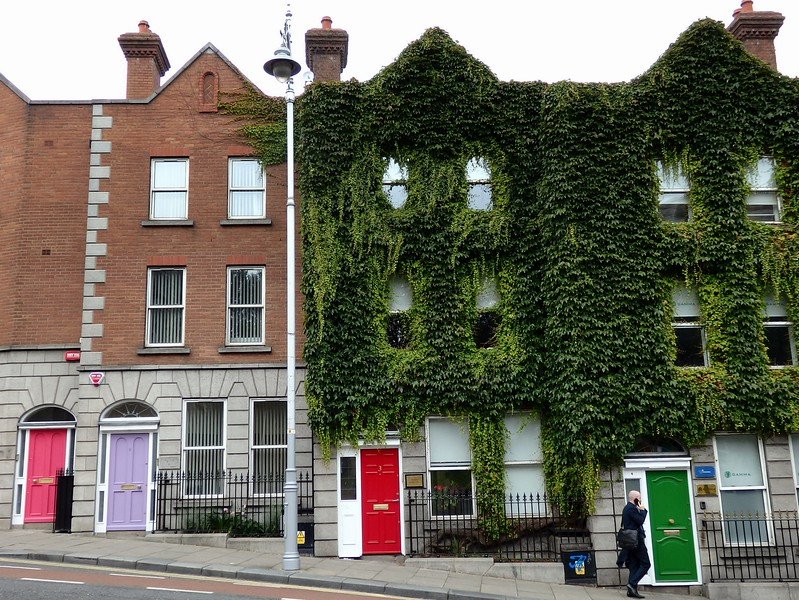

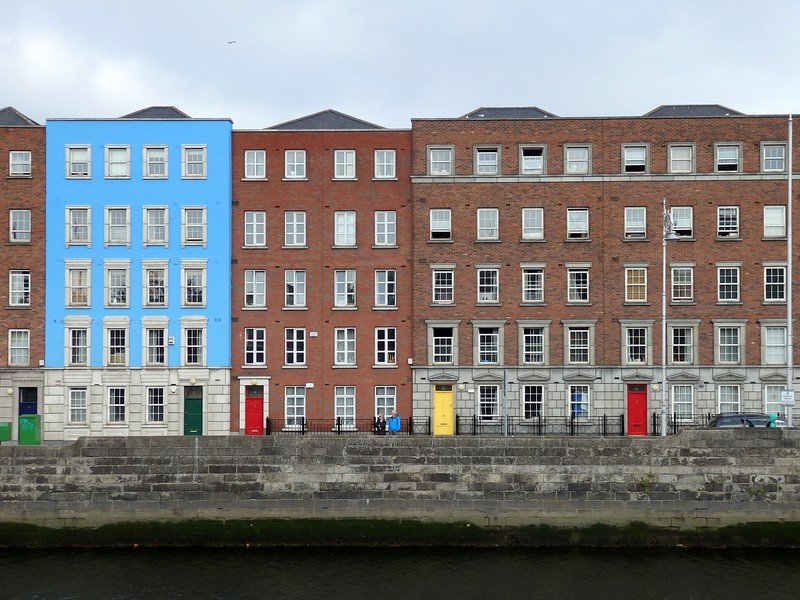
Go in search of colourful doors
When you live in a city that gets quite a bit of rain and cloud coverage, you have to find a way to brighten things around you, and in Dublin that’s done by painting doors in cheery colours. It didn’t matter what part of town we were walking through, we always managed to find bright doors in varying shades of red, yellow, lavender, green, pink and royal blue.
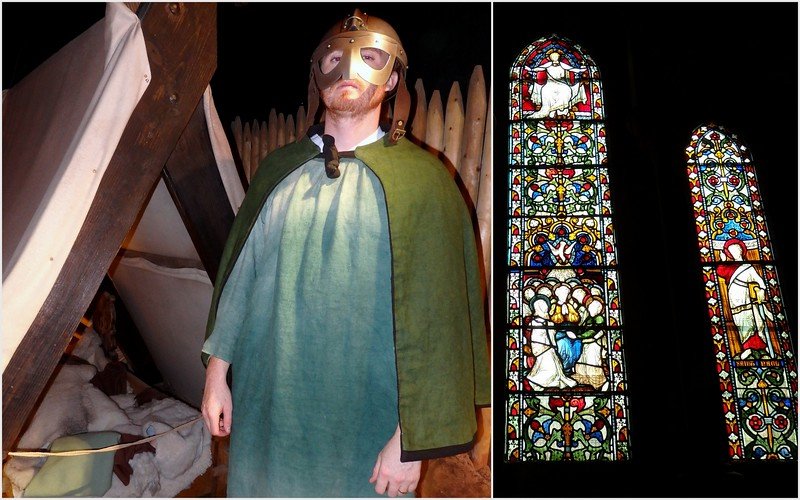
Dress up like a Viking at Dublinia
We kind of ended up in Dublinia by accident (we really needed the bathroom and admission wasn’t too pricey), and while I think their target market is probably families with children, we ended up having a lot of fun just the same way. Sam even dressed like a Viking!
Dublinia is a museum exhibition that walks you through Viking and Medieval Dublin, so we ended up learning a lot about the city’s history as well as how its residents used to live. They had huts with a hearth fire so you could see what homes were like, trunks full of clothes and weaponry so that you could dress up as a Viking, and very lifelike figures showcasing what death and disease looked like in those times. It was as realistic a look as you’re going to get into the city’s past.
From there, our admission ticket also gave us access to St. Michael’s Tower, which is a seventeenth century viewing tower that belonged to the church of St Michael the Archangel. It’s 96 steps to reach the top and you get 360 degree views of the city. It was also interesting to learn that the church bell was rung when the weather changed and the waters turned stormy, so that the local population would immediately start praying for their sailors out at sea.

Take a morning stroll through the Botanic Gardens
The National Botanic Gardens are a short bus ride from the city centre and it’s a really nice place to visit in the early morning. We went inside the greenhouses, walked along the trails, and just enjoyed the serenity of it all. They also had a cool art exhibition set up in the gardens when we visited. The one I really liked was a living room scene: sofa, television, and side table with a porcelain tea cup and saucer. It kind of made you think about how many hours can be wasted in front of the television (or watching Netflix on your phone!) when there’s a beautiful world outside waiting to be enjoyed.
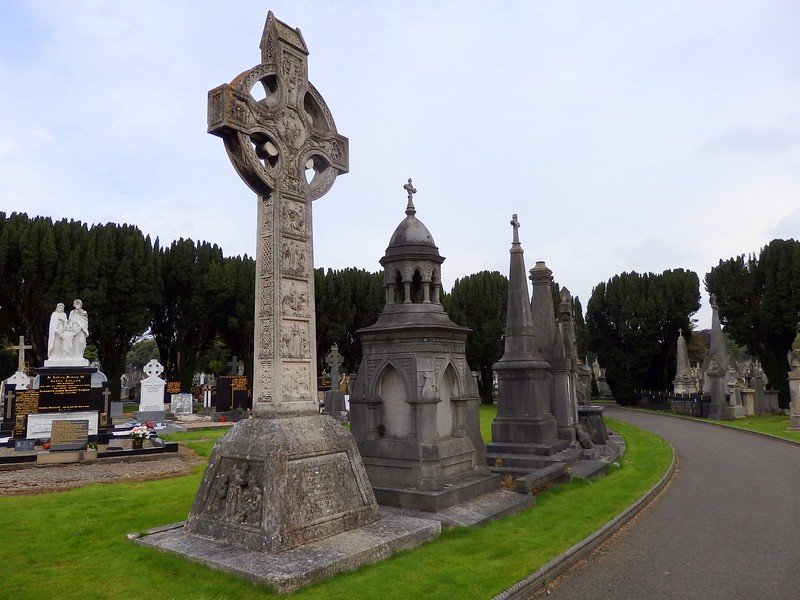
Visit the Glasnevin Cemetery
Not too far from the Botanic Gardens, you’ll also find the Glasnevin Cemetery. I know visiting a cemetery sounds a bit morbid, but Glasnevin really ties in with Dublin’s history.
Before the establishment of Glasnevin Cemetery, Irish Catholics had no cemeteries of their own where they could bury their dead, and they could only conduct a limited version of their own funeral services in Protestant churchyards and graveyards.
Daniel O’Connell, was a Catholic rights activist who campaigned for the creation of a burial ground in which both Irish Catholics and Protestants could give their dead dignified burial; Glasnevin was that place, and today you can find O’Connell’s tomb inside the crypt at the bottom of the round tower.
Another interesting fact is that the high walls and watch-towers surrounding the cemetery were built to deter bodysnatchers, who were active in Dublin in the 18th and early 19th centuries. These bodysnatchers, also known as resurrectionists, would steal bodies from graves to sell them to medical schools.
Sample Irish food
Quick, name an Irish dish. Got anything? And no, fish and chips doesn’t count.
Irish cuisine may not be well known, but you can sure find some tasty dishes in Dublin. We found that potatoes and mutton were some popular ingredients, and since we visited in the fall, we also tried a lot of stews and hearty meals to keep us warm.
A few dishes I would recommend trying are: beef and Guinness pies, because when in doubt just add some beer to your beef pie; boxty, a grated raw potato and mashed potato dish cooked on a griddle; and Irish stew, a thick stew made with lamb, potatoes, onions, and carrots which is cooked for hours until tender.
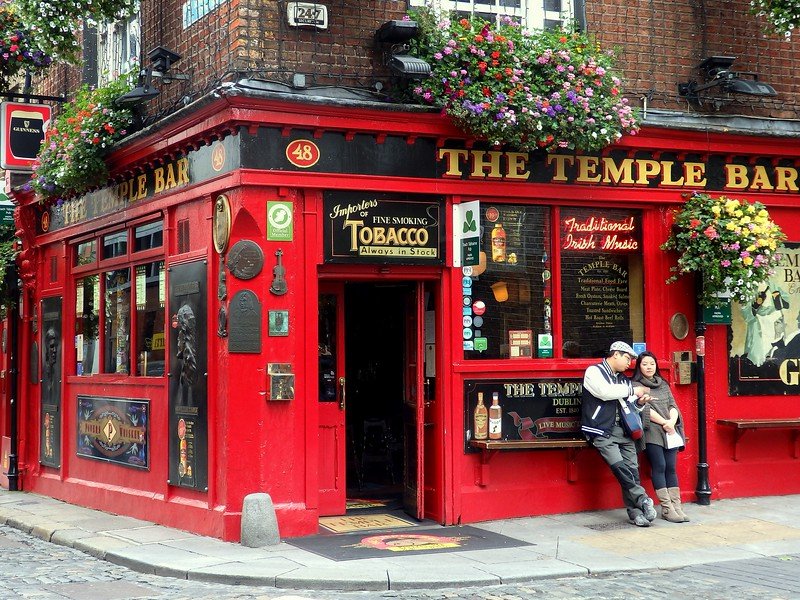
Enjoy a night out in Temple Bar
Lastly, it wouldn’t be a proper visit to Dublin without enjoying at least one night out in Temple Bar.
One of the first things I learned upon my arrival in Dublin is that Temple Bar is not one single bar; there may be a bar called The Temple Bar, but Temple Bar itself is an area south of the River Liffey which is renowned for its nightlife. The place is lined with colourful pubs decked out with flowers and flags from around the world, and when the sun goes down, this is the place to be.
We ended up at a place called The Norseman, but you really can’t go wrong with any place that’s playing live music and is teeming with jolly patrons.
Best part of the night was when Sam went to the bar to grab some drinks for my sister and my friend who were visiting. Sam walked over with his bright red hair and two Israeli girls turned to him, “You look Irish! Can you speak Irish?” He tried explaining that he is Canadian, but they didn’t think this was a possibility. “Please. We just want to hear a little bit of Irish.” I guess he better brush up on his Irish Gaelic if he plans on wearing that paddy cap around.

One-Week Dublin Trip Planner: Tips, Easy Days, Cosy Pubs & Rain-Proof Plans
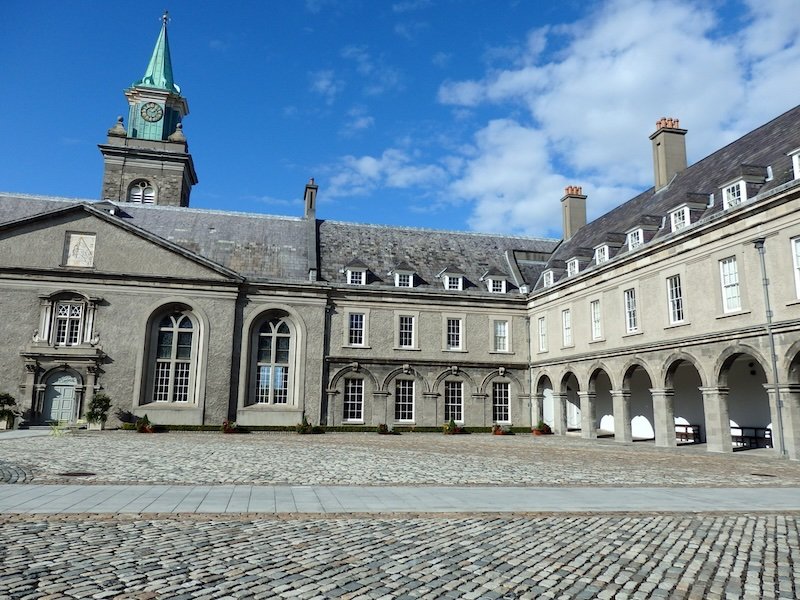
A Flexible 7-Day Itinerary (Swap Days Around as Weather Demands)
Day 1 – Old Souls & Warm Bowls (City Core + Trinity)
Ease in with Trinity College (campus tour + Book of Kells) and the Old Library. Follow with a slow wander around Grafton Street for buskers and window-shopping, then loop Merrion Square to pay respects to a lounging Oscar Wilde. If the wind bites, duck into a café for a bowl of Irish stew and a brown soda bread dunk. Evening: your first Temple Bar live-music session—earlier on weeknights for seats.
Day 2 – Viking Bones & Medieval Stones (Christchurch + Liberties)
Start at Dublinia for hands-on Viking lore, then step over the walkway to Christ Church Cathedral. Meander into The Liberties (one of Dublin’s oldest neighbourhoods) for stout history, street art nooks, and old markets. Pub dinner near The Brazen Head (Ireland’s oldest pub) to keep the timeline theme going. Nightcap: Irish coffee (whiskey) vs. Bailey’s coffee showdown—there are no losers.
Day 3 – Parks, Tea & Georgian Doors (Northside Calm)
Morning at the National Botanic Gardens, followed by Glasnevin Cemetery for history that reads like a who’s who of Ireland. Afternoon photo stroll: go door-spotting around leafy Georgian squares (hot tip: Fitzwilliam/St. Stephen’s/Merrion). Dinner near St. Stephen’s Green; evening traditional music session somewhere intimate—look for fiddles, flutes and a bodhrán tapping away.
Day 4 – Guinness vs. Whiskey (You Decide the Winner)
Choose your own sip-venture:
- Guinness Storehouse for brewing heritage and rooftop Gravity Bar views, or
- Jameson (Smithfield) for a guided tasting of smooth Irish whiskey.
Either way, balance tastings with carbs (boxty pancakes, pies, or a classic fish & chips). Sunset along the River Liffey bridges for blues and golds on good weather days.
Day 5 – Deer & Peace (Phoenix Park)
Bus or bike to Phoenix Park; keep an eye out for herd movement near the woods south of the Papal Cross. Pack a thermos and snack; the park is huge and perfect for a slow digital detox. Back in town, try a gastropub (modern twist on classics), then chase one more pub with live trad—Sunday afternoons are gold if your timing lines up.
Day 6 – Museums & Rainy-Day Grazing
When the forecast sulks: pivot to the National Museum cluster (Archaeology for bog bodies and gold; Decorative Arts & History for everything from uniforms to silverware; Natural History for Victorian vibes) or National Gallery for Caravaggio to Yeats. Build a grazing lunch from bakeries and delis; finish with a cheeky elevenses—tea + a slice of Victoria sponge or a caramel square.
Day 7 – Coastal Breather (Howth, Bray or Malahide)
Clear the head with sea air (details in the Day Trips section). Back in Dublin, last-night splurge: tasting menu (modern Irish), or keep it classic with beef & Guinness pie, mashed potatoes and a pint. One more wander under fairy lights and you’ll be plotting your return.
Where to Stay in Dublin (By Vibe)
| Neighbourhood | Best For | What it feels like | Consider |
|---|---|---|---|
| Temple Bar / City Centre | Nightlife, short strolls to sights | Lively, music spilling onto cobblestones | Noisy late; pricier |
| St. Stephen’s Green / Grafton | Shopping, cafés, Georgian beauty | Leafy, elegant, central | Popular = book early |
| Merrion / Ballsbridge | Quiet nights, embassies, museums | Residential-chic, stately | Slightly longer walks |
| Smithfield / Stoneybatter | Jameson, indie cafés, markets | Creative, up-and-coming | 15–20 min walk to core |
| Grand Canal Dock | Modern stays, business traveller ease | Sleek, waterside paths | Fewer old-pub vibes |
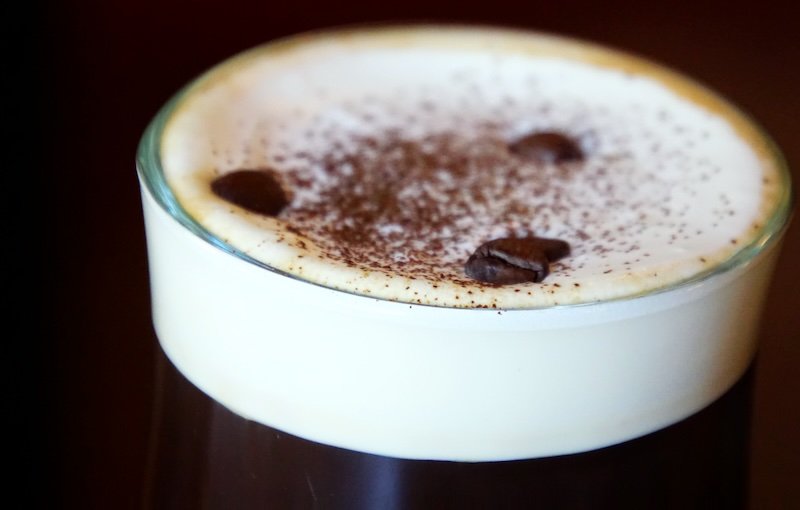
Eating & Drinking Essentials (What to Try, Where to Learn)
Classic Dishes to Hunt Down
- Irish stew (lamb, potatoes, carrots, onions, time and love)
- Boxty (potato pancake—try stuffed versions)
- Coddle (sausage, bacon, potatoes—rainy-day hug)
- Beef & Guinness pie (pastry lid, rich gravy)
- Seafood chowder (west coast goodness, but widely served)
- Brown soda bread with Kerrygold butter (smear generously)
Sweet Things
- Apple tart with cream
- Bread and butter pudding (don’t skip the custard)
- Caramel squares (aka millionaire’s shortbread)
- Flapjacks (oaty, chewy)
Pub Etiquette (Tiny Tips That Help)
- Order at the bar; you’ll often pay as you go.
- If there’s a trad session, keep chatter low near the musicians’ circle—pull pints, not focus.
- Table nursing is fine, but offer your seat to those with food or mobility needs.
- A smile and a “Cheers, thanks a million!” goes further than exact change.
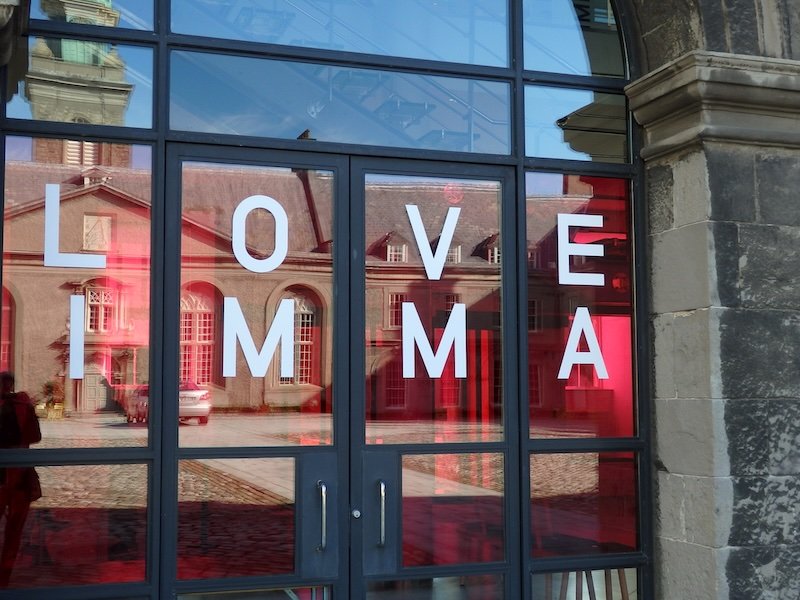
Budget & Booking Cheatsheet
| Category | Shoestring | Savvy Mid | Treat Yo’Self |
|---|---|---|---|
| Breakfast | Bakery + takeaway coffee | Full Irish in a pub | Hotel brunch |
| Lunch | Soup + soda bread | Pie/boxty + soft drink | Michelin-adjacent lunch special |
| Dinner | Pub mains | Gastropub or mid-range bistro | Tasting menu, wine pairing |
| Sips | Happy-hour pint | Craft beer flight or Irish coffee | Whiskey tasting or cocktail bar |
| Sights | Free museums, parks, churches (donation) | One major paid attraction/day | Multiple tours + add-ons |
Passes: Multi-attraction passes can be great if you’re museum-heavy; otherwise, pick à la carte. Prebook hot tickets (Book of Kells, Guinness, Jameson) on weekends and holidays.
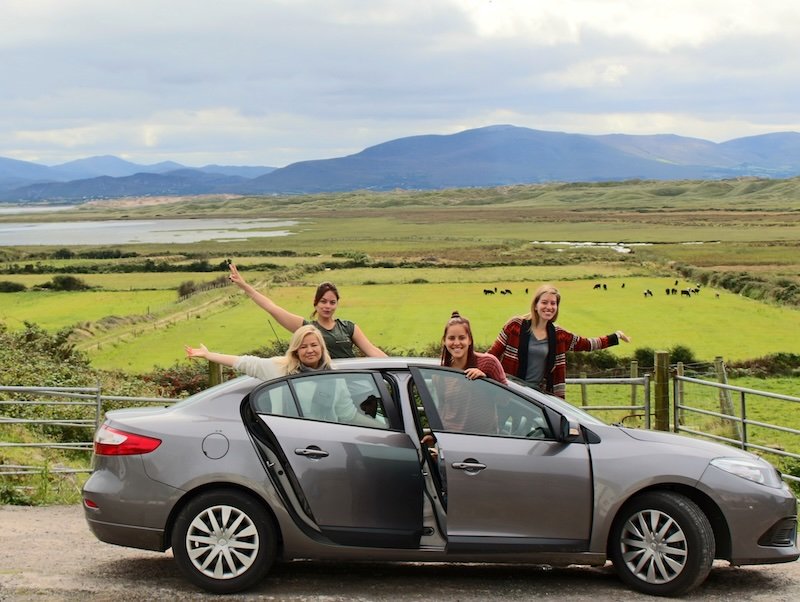
Getting Around (and Around the Weather)
- On foot: Dublin rewards wandering—pack comfy waterproof shoes.
- Bus / Tram (Luas) / DART: Easy taps, frequent service. DART hugs the coast for day trips (Howth, Bray, Malahide).
- Taxis / Rideshare: Handy late at night or in sideways rain.
- Bikes: Great in parks and along canals; mind the cobblestones and drizzle.
Rain Plan Playbook
- Morning downpour? Museums first, parks later.
- Wind picking up? Georgian doors photo stroll—short bursts outside, café pit-stops.
- Sheets of rain? Food crawl: soup here, pastry there, coffee everywhere.
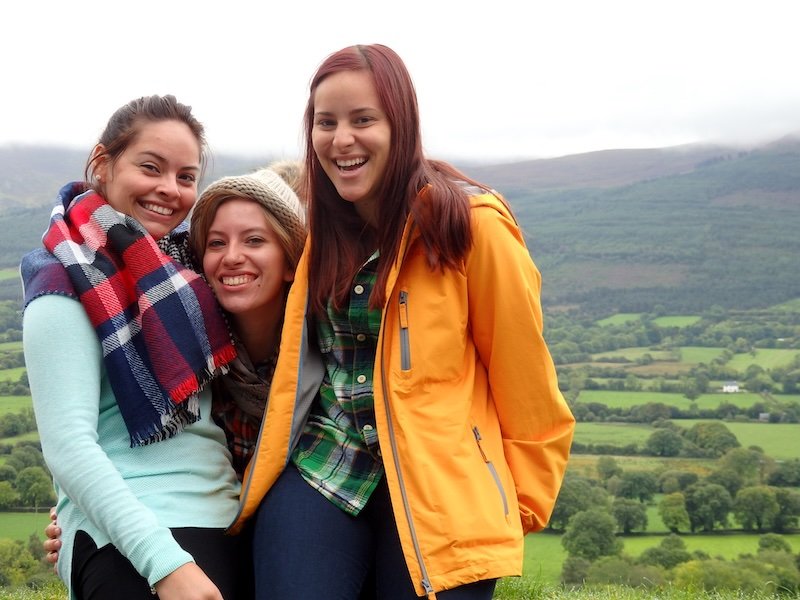
Easy Day Trips by Train (No Car Needed)
Howth (30 min, DART)
A pretty fishing village at the city’s fringe. Stroll the Howth Cliff Path Loop (choose the short route if winds howl), ogle seals in the harbour, then reward yourself with fish & chips. Views sweep from lighthouse to wide-open sea.
Bray & Greystones (40–50 min, DART)
Walk the Bray–Greystones Cliff Walk (bring layers; it’s exposed), then café-hop in either town. If you’re feeling mellow, stay in Bray for a seafront amble and a slow lunch.
Malahide & Portmarnock (30–40 min, DART)
Malahide Castle (book a tour) comes with gardens and peacocks if they’re in the mood. Combine with a sandy stroll along Portmarnock or Malahide Beach for sea air therapy.
Kilkenny (train + wander)
Storybook Kilkenny Castle, medieval lanes and craft studios. A full day but easy: train, walk, eat something buttery, repeat.
Glendalough & Wicklow (bus/coach)
Monastic ruins, lakes and valley walks. Weather-dependent but hauntingly beautiful in mist—bring waterproofs and snacks.
Boyne Valley (coach)
Neolithic passage tombs (Newgrange/Knowth) and big-picture Irish history. Prebooked tours simplify logistics.
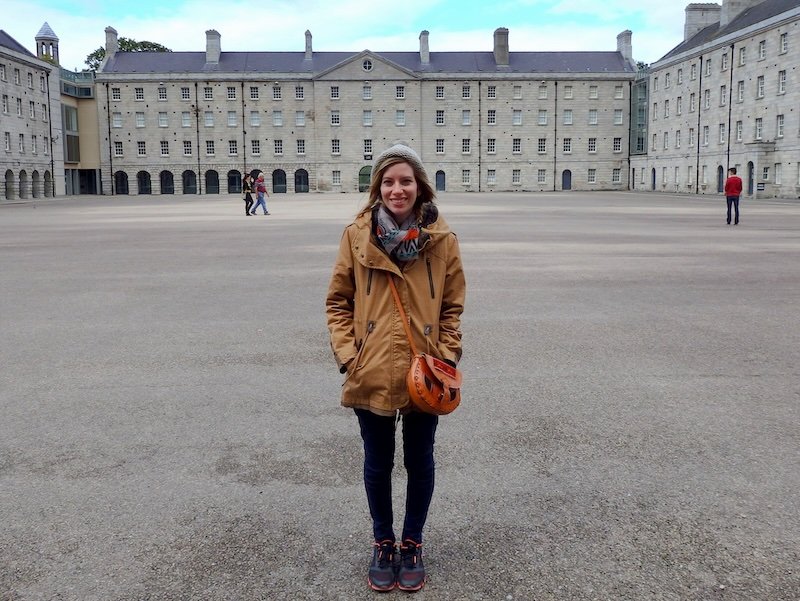
Packing Checklists (Season-Proof)
The Dublin Basics
- Waterproof jacket with hood
- Compact umbrella (bonus points: clear)
- Waterproof shoes/boots with grip
- Warm layers (fleece/wool) year-round
- Scarf, hat, gloves (even in “summer” you’ll often want one)
- Cross-body bag (zips + hands-free for photos)
- Portable charger, reusable water bottle, tissues
- Tiny tote (for bakery runs and books you “weren’t going to buy”)
For Pub Nights
- Card + a bit of cash
- Photo ID
- Offline map pinned for the walk home
- Respectable appetite
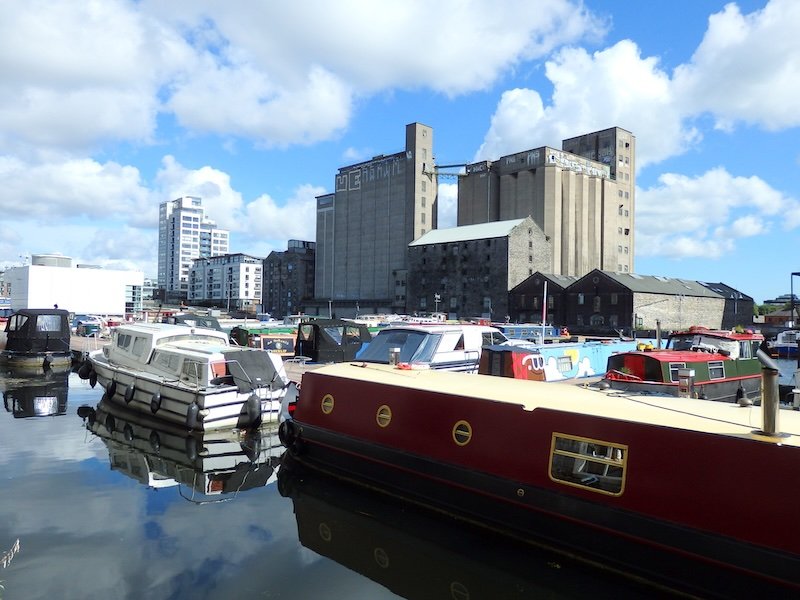
Dublin Travel FAQ
How many days do I actually need in Dublin?
Three full days cover headline sights with a pub or two; a week lets you balance weather days, add a coastal jaunt, and slow down over lingering lunches. If you love literary stops and live music, the extra time makes Dublin bloom.
Is Dublin walkable or should I rely on transit?
The historic core is very walkable; most big sights sit within a 20–30 minute meander. For rain days or longer hops, buses and the Luas tram are straightforward, and the DART train is your friend for the seaside.
What’s the best time of year to visit?
Spring brings blossoms and longer light, summer means festivals and patios (and crowds), autumn equals cozy pub weather and golden parks, and winter swaps flowers for fairy lights. Dublin’s charm is less about temperature and more about mood—pack layers and say yes to stew.
Do I need to prebook the Book of Kells, Guinness or Jameson?
For weekends and holidays, yes—timed entries help you avoid long lines. Weekdays shoulder-season can be more forgiving, but if a sight is a must-do for you, secure a slot.
Where can I hear authentic traditional music?
Look for pubs advertising live trad sessions in the early evening or Sunday afternoons. Smaller, wood-paneled rooms with seated musicians feel most intimate. If you see fiddles, a flute and a drum (bodhrán), you’re in the right place.
What should I order if I want something distinctly Irish?
Start with Irish stew or boxty, tuck into beef & Guinness pie, and finish with bread and butter pudding. For sips, alternate a Guinness with an Irish coffee or a whiskey tasting flight.
Is Temple Bar really worth the hype?
It’s touristy and fun—especially for first-timers chasing music and buzzy streets. Pop in early evening for atmosphere, then branch to nearby neighbourhood pubs once you’ve had your fill of selfies and flower boxes.
What’s a good rainy-day plan that still feels special?
Do the museum triangle (Archaeology → Gallery → Decorative Arts) with café stops in between, then cap it with a warming whiskey or Irish coffee and a hearty pub dinner. Rain on cobbles from a pub window is a vibe.
Can I see deer in Dublin without leaving the city?
Yes—Phoenix Park is famous for its resident herd. Go around dawn or late afternoon and scan the tree lines near the Papal Cross. Keep a respectful distance and never feed wildlife.
Are day trips easy without renting a car?
Absolutely. The DART gets you to Howth, Bray and Malahide; coaches run to Glendalough, Kilkenny, and the Boyne Valley. Pick one coastal hop for sea air and one countryside trip for ruins and rolling hills.
What’s pub etiquette I should know before I walk in?
Order at the bar, say please and cheers, and bus your glass if you’re near the return shelf. If you nab a seat during a trad session, keep conversation low and clap along—no need to out-sing the fiddle.
Any neighborhoods that feel local but are still convenient?
Try Stoneybatter (craft coffee, indie eats), Smithfield (Jameson, markets), or the streets around Portobello (canals and casual dining). They’re close enough to walk or tram into the core, but quieter when the music fades.
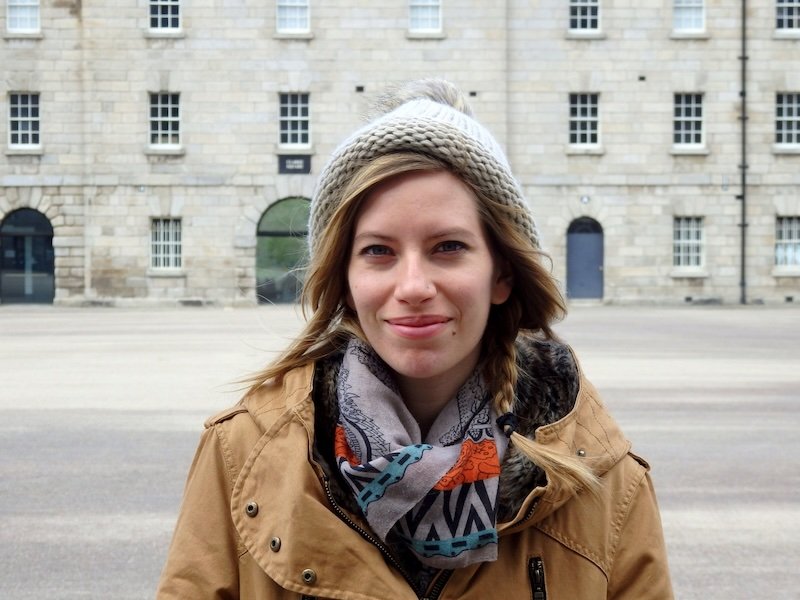
Have you been to Dublin?
What were some of your highlights?

Glasnevin is a great day out for all the family. We brought our teenage daughter and she was every bit as interested as we were. Our tour guide was excellent and gave us lots of information that we would not have known otherwise. We visited all the famous graves and we were given the history and stories behind these and hotel Temple bar hotel is situated in great location, walking distance to most common sights. Service was pleasant and fast. Windows should be double-glass in my opinion..
That sounds like a great outing. I didn’t visit Glasnevin with a guide, but if I had to do it again, I would. It’d be great to hear all the stories and learn even more of the history. I hope you enjoyed the rest of your trip in Dublin.
We’re heading to Dublin soon and your pass totally inspired us to get the Heritage pass and check out the Gardens and Park! Thanks for the great tips 🙂
Leaving for Dublin in a month and a half- This really helped me make a list of fun things to do while there for a week too!
Thanks!!
Studying abroad in Europe this semester and have used your guides in every town we’ve visited!! Dublin is my next impulse weekend – this is so helpful!!
This is a great list 🙂 Also, Glendalough is a great day trip from Dublin! If you rent a car, it’s about an hour and 20 minutes driving, but there are also buses you can hire. Once you get there, you can hike around the lake or visit ancient monastic ruins.